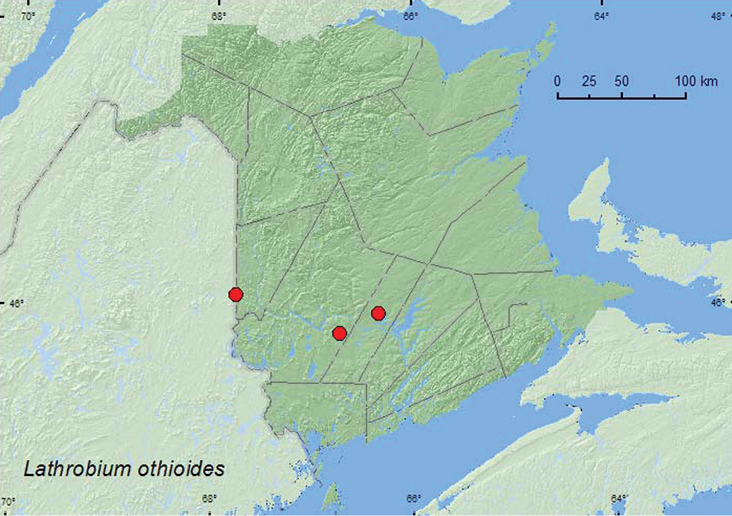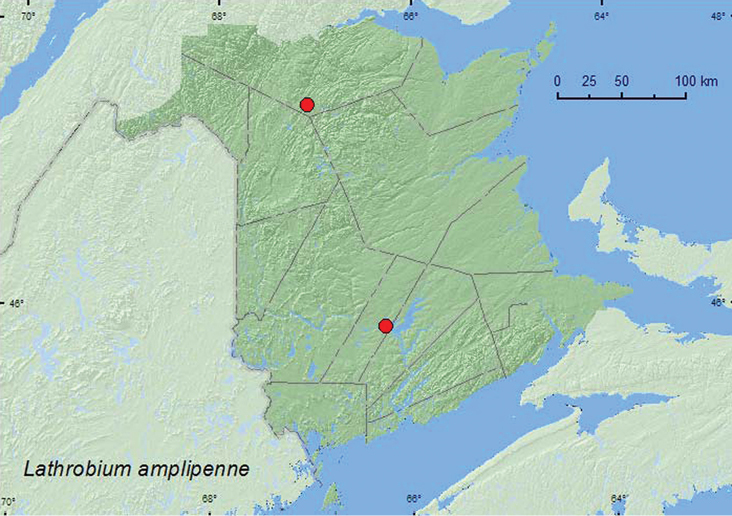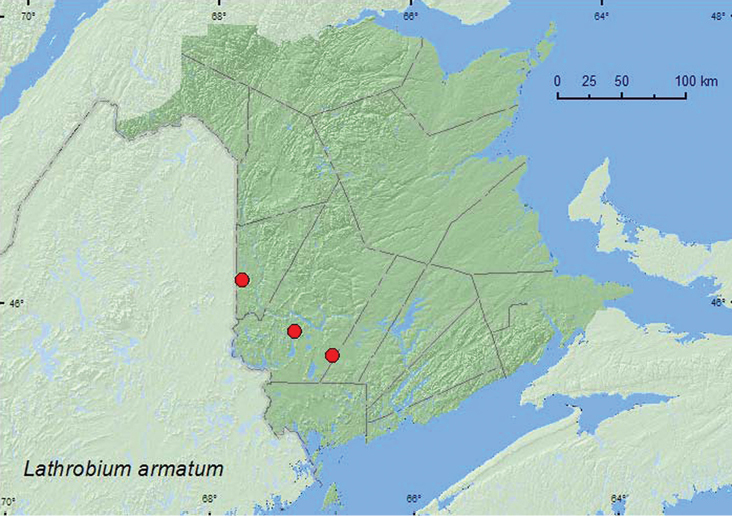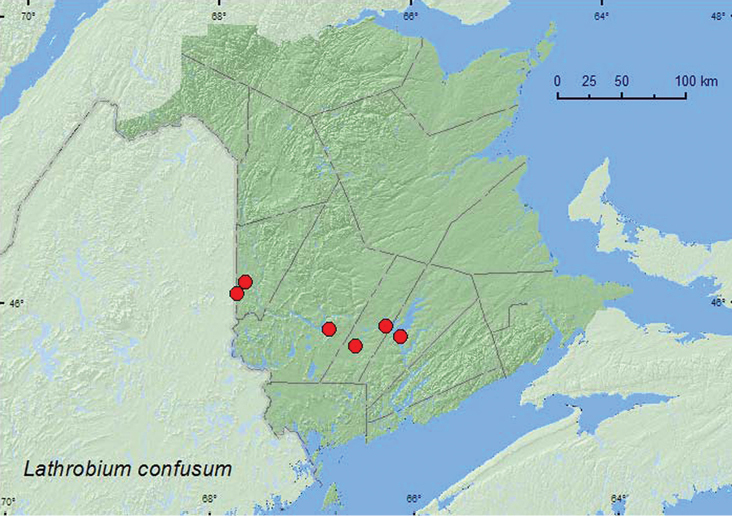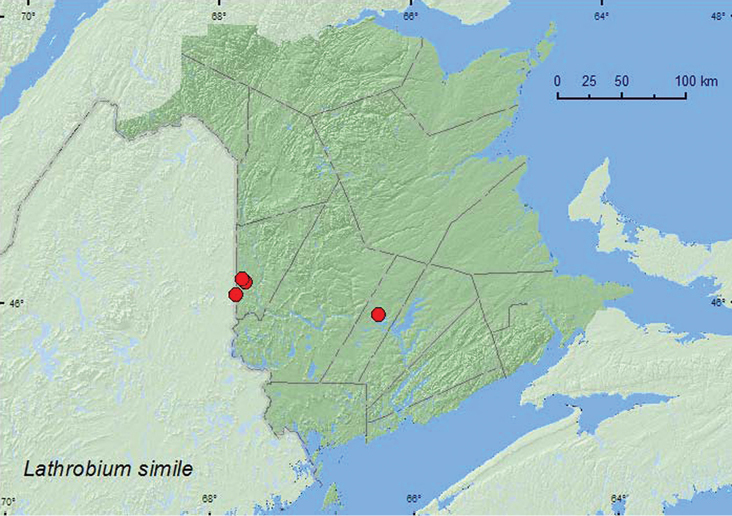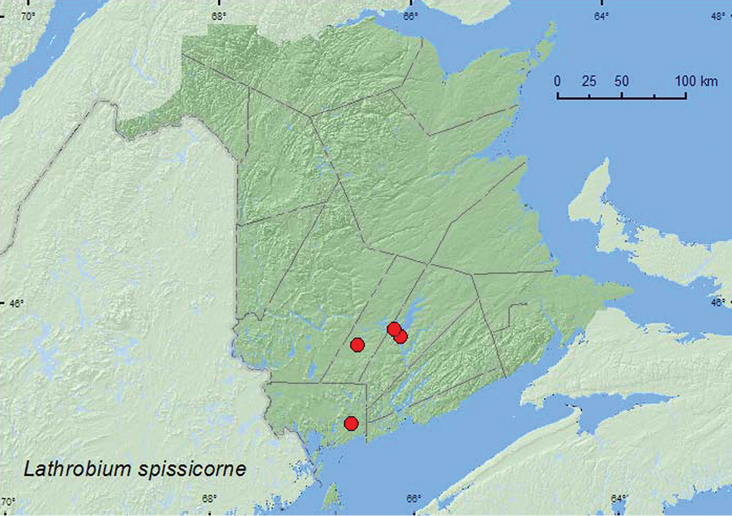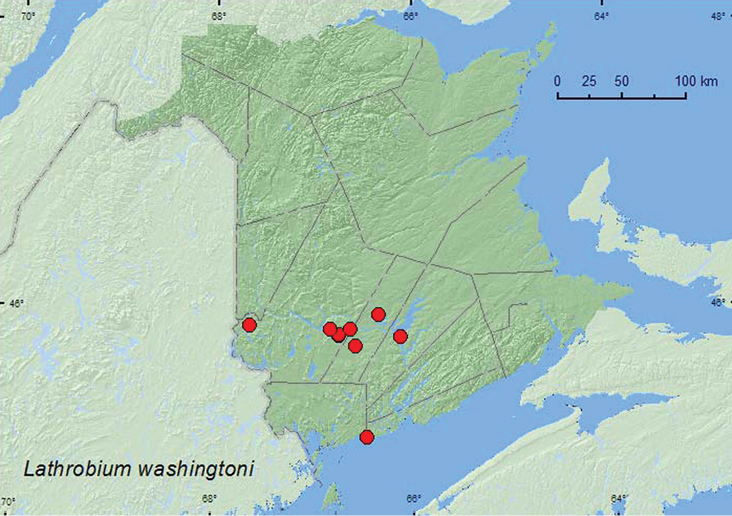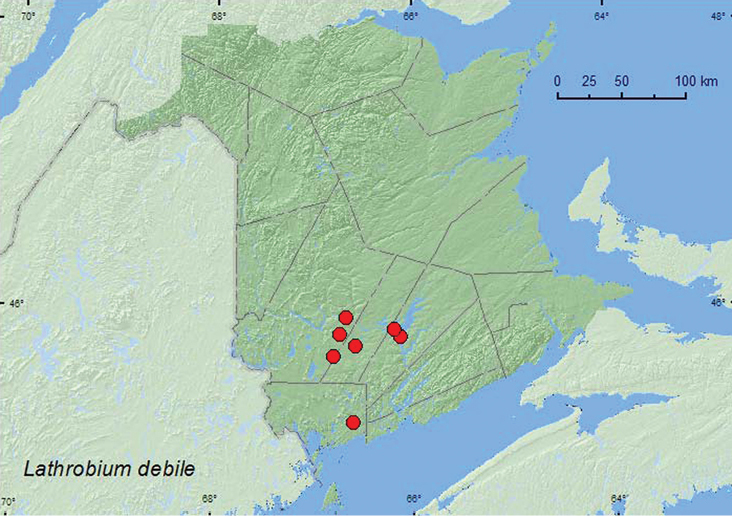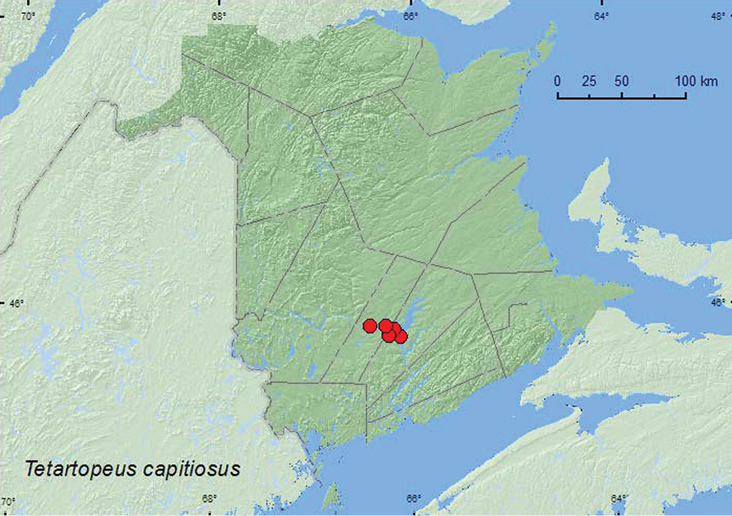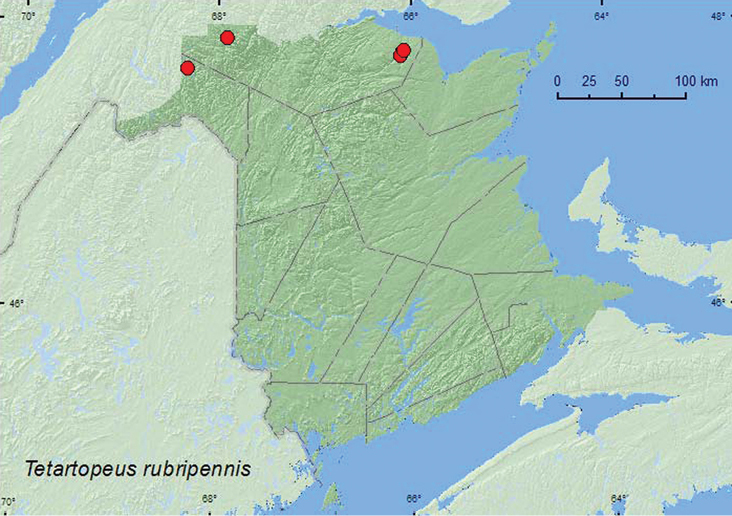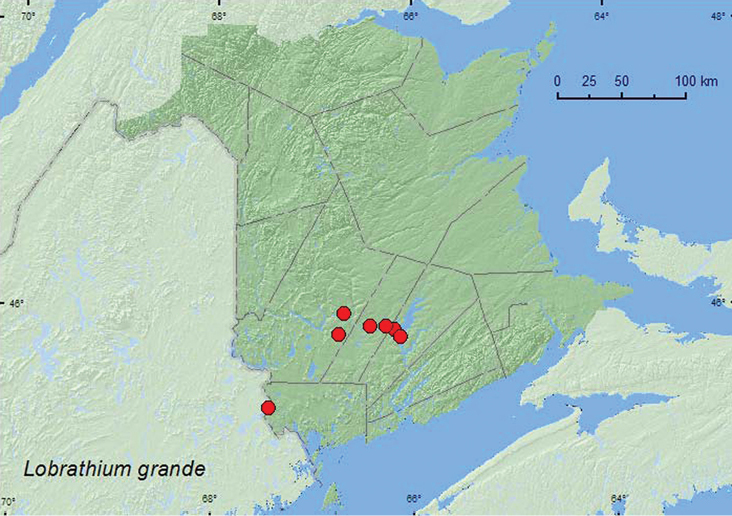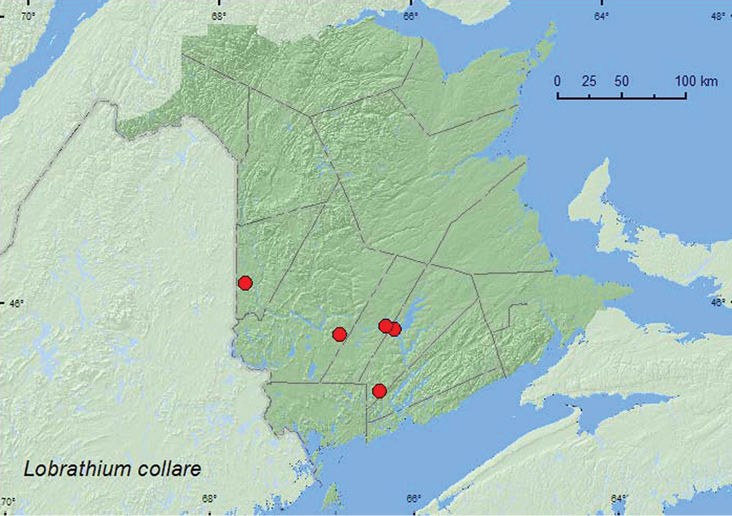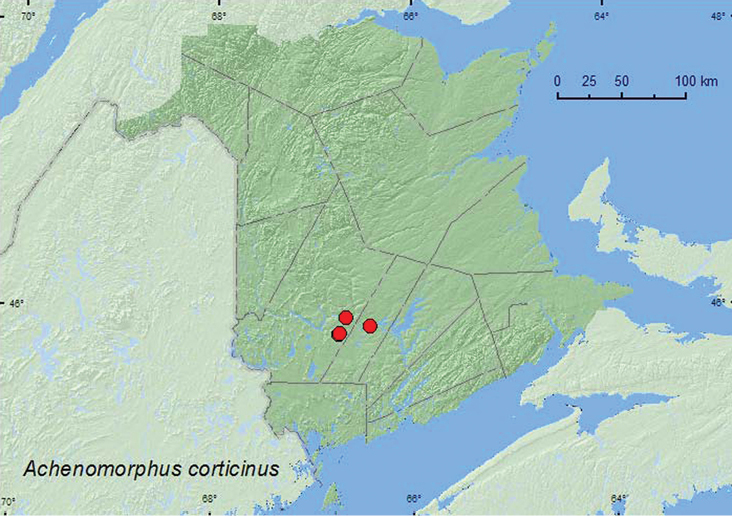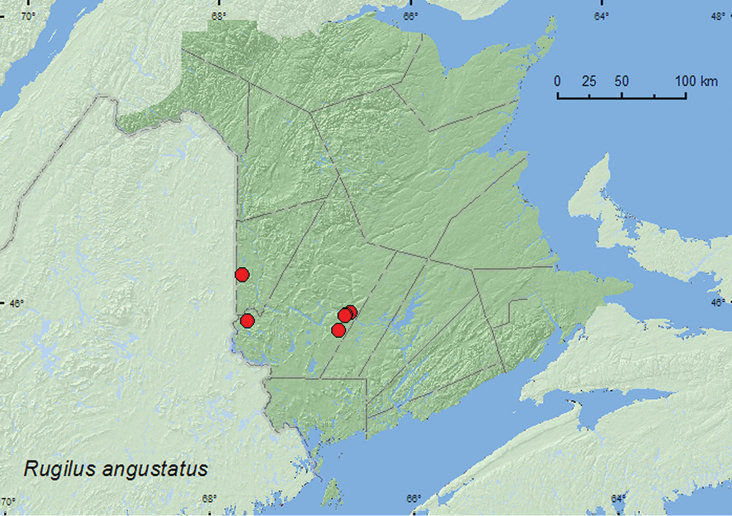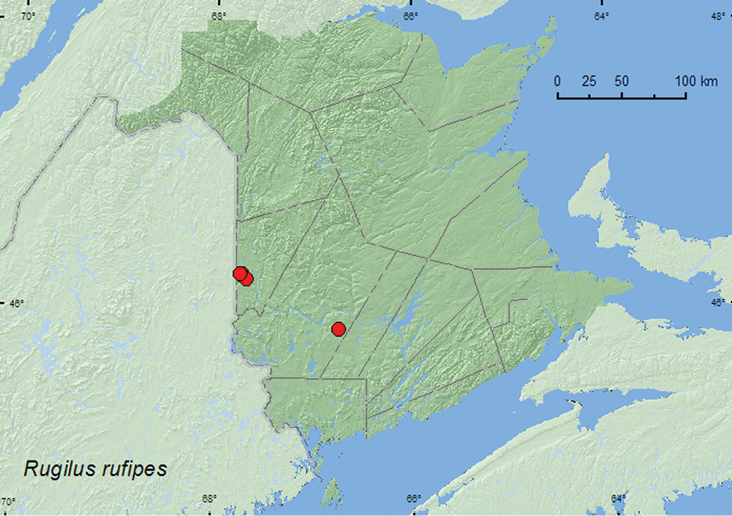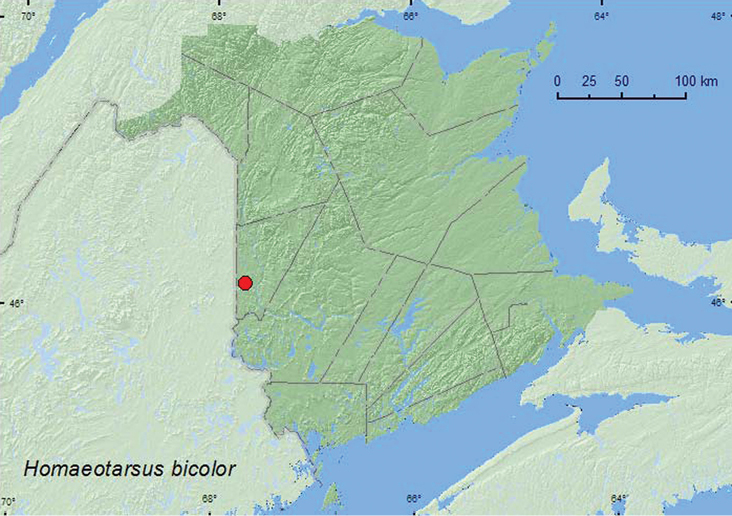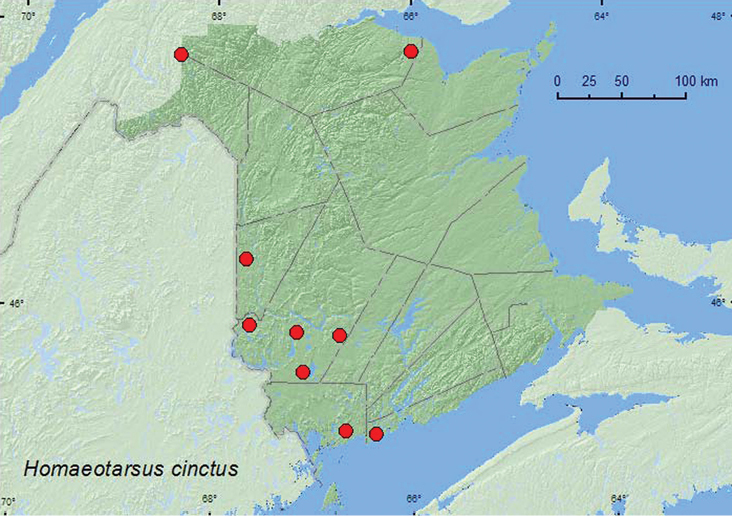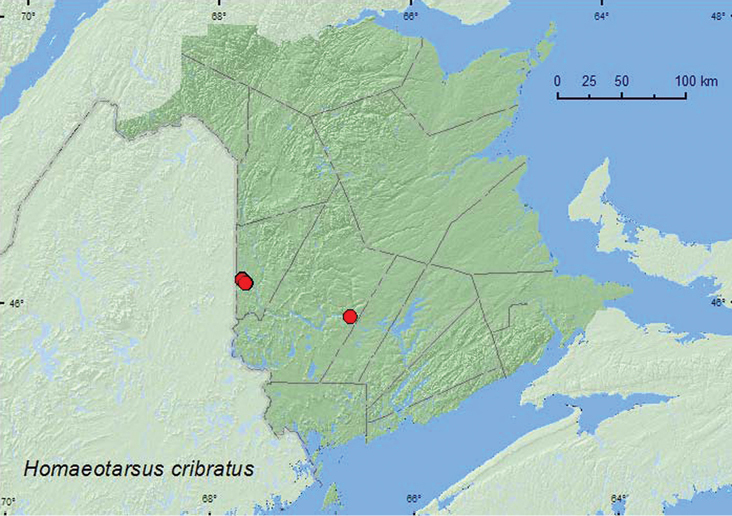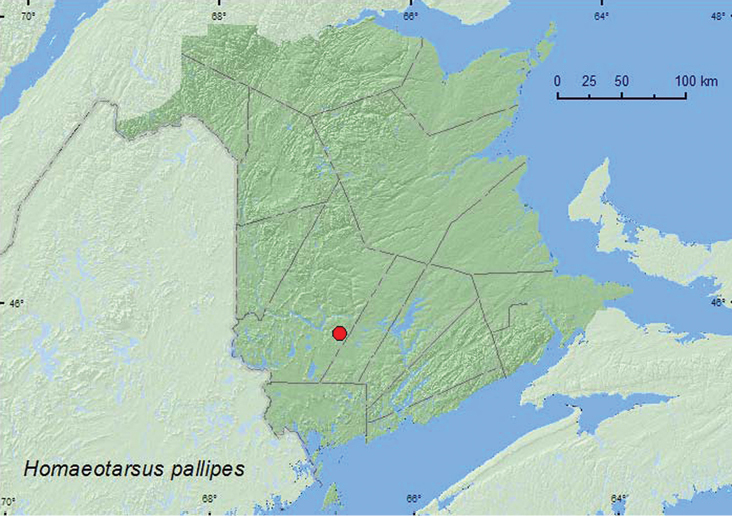






(C) 2012 Reginald P. Webster. This is an open access article distributed under the terms of the Creative Commons Attribution License 3.0 (CC-BY), which permits unrestricted use, distribution, and reproduction in any medium, provided the original author and source are credited.
For reference, use of the paginated PDF or printed version of this article is recommended.
We report 17 species of Paederinae new for New Brunswick, Canada. Ten of these species, Lathrobium othioides LeConte, Lathrobium amplipenne Casey, Lathrobium armatum Say, Lathrobium confusum LeConte, Lathrobium debile LeConte, Achenomorphus corticinus (Gravenhorst), Rugilus rufipes Germar, Homaeotarsus bicolor (Gravenhorst), Homaeotharsus cribratus (LeConte), and Homaeotarsus pallipes (Gravenhorst) are newly recorded for the Maritime provinces. This brings the total number of Paederinae recorded from New Brunswick to 36 species. Additional records are presented for the recently reported Lathrobium simile LeConte and Lathrobium washingtoni Casey. Collection and habitat data are presented for all species.
Paederinae, new records, Canada, New Brunswick
This paper treats new Staphylinidae records from New Brunswick of the subfamily Paederinae. The most recent taxonomic treatments of the North American Paederinae fauna were by
Many species of Paederinae in Canada occur in and near wetland habitats such as marshes, bogs, and pond and river margins (
The following records are based on specimens collected as part of a general survey to document the Coleoptera fauna of New Brunswick and from by-catch samples from Lindgren 12-funnel traps (
Various collection methods were employed to collect the species reported in this study. Details are outlined in
Males and some females of most species were dissected to confirm their identity. The genital structures were dehydrated in absolute alcohol, mounted in Canada balsam on celluloid microslides, and pinned with the specimens from which they originated.
DistributionDistribution maps, created using ArcMap and ArcGIS, are presented for each species in New Brunswick. Every species is cited with current distribution in Canada and Alaska, using abbreviations for the state, provinces, and territories. New provincial records are indicated in bold under Distribution in Canada and Alaska. The following abbreviations are used in the text.
Acronyms of collections examined and referred to in this study are as follows:
| AK | Alaska | MB | Manitoba |
| YT | Yukon Territory | ON | Ontario |
| NT | Northwest Territories | QC | Quebec |
| NU | Nunavut | NB | New Brunswick |
| BC | British Columbia | PE | Prince Edward Island |
| AB | Alberta | NS | Nova Scotia |
| SK | Saskatchewan | NF & LB | Newfoundland and Labrador* |
*Newfoundland and Labrador are each treated separately under the current Distribution in Canada and Alaska.
AFC Atlantic Forestry Centre, Natural Resources Canada, Canadian Forest Service, Fredericton, New Brunswick, Canada
CNC Canadian National Collection of Insects, Arachnids and Nematodes, Agriculture and Agri-Food Canada, Ottawa, Ontario, Canada
NBM New Brunswick Museum, Saint John, New Brunswick, Canada
RWC Reginald P. Webster Collection, Charters Settlement, New Brunswick, Canada
ResultsUnless noted otherwise (additional records), all records below are species newly recorded for New Brunswick, Canada. Species followed by ** are newly recorded from the Maritime provinces (New Brunswick, Nova Scotia, Prince Edward Island) of Canada.
Species accountsThe classification of the Paederinae follows
Seventeen species of Paederinae are newly reported for the New Brunswick, Canada. Ten of these are newly recorded for the Maritime provinces. This brings the total number of Paederinae recorded from New Brunswick to 36 (Table 1). Additional records and bionomic data of the recently reported Lathrobium simile and Lathrobium washingtoni are presented.
Species of Paederinae (Staphylinidae) recorded from New Brunswick, Canada.
| Subfamily Paederinae Fleming |
| Tribe Paederini Fleming |
| Subtribe Lathrobiina Laporte |
| Lathrobium (Lathrobioma) scolopaceum (Casey) |
| Lathrobium (Lathrobioma) othioides LeConte** |
| Lathrobium (Lathrobium) amplipenne Casey** |
| Lathrobium (Lathrobium) armatum Say** |
| Lathrobium (Lathrobium) confusum LeConte** |
| Lathrobium (Lathrobium) fauveli Duvivier |
| Lathrobium (Lathrobium) fulvipenne (Gravenhorst) |
| Lathrobium (Lathrobium) simile LeConte |
| Lathrobium (Lathrobium) sparsellum Casey |
| Lathrobium (Lathrobium) spissicorne Casey* |
| Lathrobium (Lathrobium) washingtoni Casey |
| Lathrobium (Lathrolepta) debile LeConte** |
| Lobrathium (Lobrathium) collare (Erichson)* |
| Lobrathium (Eulathrobium) grande (LeConte)* |
| Tetartopeus angularis (LeConte) |
| Tetartopeus furvulus Casey |
| Tetartopeus lacustris Casey |
| Tetartopeus niger (LeConte) |
| Tetartopeus nitidulus (LeConte) |
| Tetartopeus capitosus Casey* |
| Tetartopeus rubripennis Casey* |
| Subtribe Medonina Casey |
| Achenomorphus corticinus (Gravenhorst)** |
| Lithocaris (Lithocharis) ochracea (Gravenhorst) |
| Pseudomedon thoracica Casey |
| Sunius (Trachysectus) confluentus (Say) |
| Subtribe Stilicina Casey |
| Pachystilicus hanhami (Wickham) |
| Rugilus angustatus (Geoffrey)* |
| Rugilus biarmatus (LeConte) |
| Rugilus rufipes Germar** |
| Subtribe Astenina Hatch |
| Astenus discopunctatus (Say) |
| Subtribe Cryptobiina Casey |
| Homaeotarsus (Gastrolobium) bicolor (Gravenhorst)** |
| Homaeotarsus (Hesperobium) cinctus (Say)* |
| Homaeotarsus (Hesperobium) cribratus (LeConte)** |
| Homaeotarsus (Hesperobium) pallipes (Gravenhorst)** |
| Ochthephilum fracticorne (Paykull) |
| Subtribe Paederina Fleming |
| Paederus littorarius (Gravenhorst) |
Notes: *New to province, **New to Maritime Provinces
Subfamily Paederinae Fleming, 1821
Tribe Paederini Fleming, 1821
Subtribe Lathrobiina Laporte, 1835
http://species-id.net/wiki/Lathrobium_othioides
Map 1New Brunswick, Carleton Co., Richmond, Hovey Hill Protected (Natural) Area, 46.1115°N, 67.7770°W, 10.V.2005, R. P. Webster, hardwood forest, in moist leaf litter and moss near seepage area (3 ♂, RWC). Sunbury Co., Acadia Research Forest, 45.9816°N, 66.3374°W, 18.VI.2007, R. P. Webster, 8.5 year-old regenerating mixed forest, sifting leaf litter (1 ♂, AFC). York Co., Charters Settlement, 45.8428°N, 66.7279°W, 19.IV.2004, 24.IV.2004, 15.IV.2005, 20.IV.2005, R. P. Webster, mixed forest, sedge marsh in moist grass litter and sphagnum (6 ♂, RWC).
Collection localities in New Brunswick, Canada of Lathrobium othioides.
Lathrobium othioides was found in an old hardwood forest, a regenerating mixed forest, and a sedge (Carex) marsh. Adults were sifted from leaf litter, moist leaf litter, and moss in a seepage area and from moist grass litter and sphagnum. This species was collected during April, May, and June.
ON, QC, NB (
http://species-id.net/wiki/Lathrobium_amplipenne
Map 2New Brunswick, Restigouche Co., Little Tobique River near Red Brook, 47.4465°N, 67.0689°W, 13.VI.2006, R. P. Webster, river margin in Carex hummock (1 ♂, 1 ♀, RWC). Sunbury Co., Sheffield, Portobello Creek N.W.A., 45.8952°N, 66.2728°W, 7.V.2004, R. P. Webster, silver maple swamp, in leaf litter (1 ♀, RWC).
Collection localities in New Brunswick, Canada of Lathrobium amplipenne.
Adults were sifted from a Carex hummock on a river margin and from leaf litter in a silver maple (Acer saccharinum L.) swamp. Adults were collected during May and June.
ON, NB (
New Brunswick, Carleton Co. Jackson Falls, Bell Forest, 46.2150°N, 67.7201°W, 14.V.2006, R. P. Webster, river margin, in drift material near seepage area (1 ♂, 1 ♀, RWC). York Co., Dumfries, Slagundy Dry Ponds, 45.8596°N, 67.1849°W, 8.VII.2006, R. P. Webster, large vernal pond, pond margin in moist leaves (1 ♂, 2 ♀, RWC); 8.5 km W of Tracy off Rt. 645, 45.6888°N, 66.8004°W, 22.V.2008, R. P. Webster, Carex marsh/flowage near slow flowing brook, in Carex hummocks (3 ♂, 1 ♀, RWC).
. Collection localities in New Brunswick, Canada of Lathrobium armatum.
Lathrobium armatum was sifted from drift material near a seepage area along a river margin, from Carex hummocks in a Carex marsh/flowage near a slow-flowing brook and from moist leaves on the margin of a large vernal pond. Adults were collected during May and July.
ON, QC, NB (
http://species-id.net/wiki/Lathrobium_confusum
Map 4New Brunswick, Carleton Co., near Hovey Hill P.N.A., 46.1155°N, 67.7631°W, 10.V.2005, R. P. Webster, mixed forest, in (leaf) litter near small brook (1 ♂, RWC); Meduxnekeag Valley Nature Preserve, 46.1964°N, 67.6840°W, 31.V.2005, M.-A. Giguère & R. Webster, mixed forest, vernal pond margin in moist (leaf) litter (2 ♀, NBM, RWC); same locality and forest type but, 46.1976°N, 67.6850°W, margin of vernal pond, in moist leaves (1 ♂, NBM). Queens Co., W of Jemseg at “Trout Creek”, 45.8227°N, 66.1240°W, 26.IV.2004, 9.V.2004, R. P. Webster, silver maple swamp, sifting (leaf) litter at bases of large trees (2 ♂, 1 ♀, RWC); same locality, forest type, and collector but 45.8231°N, 66.1245°W, 11.IV.2006, sifting litter from crotch of silver maple with multiple trunks (1 ♂, NBM). Sunbury Co., Sheffield, Portobello Creek N.W.A., 45.8952°N, 66.2728°W, 7.V.2004, R. P. Webster, silver maple swamp, in leaf litter (1 ♀, RWC); Burton, Sunpoke Lake, 45.7575°N, 66.5736°W, 30.IV.2004, 10.IV.2006, R. P. Webster, red maple swamp, in leaf litter near slow stream (1 ♂, 3 ♀, NBM, RWC). York Co. Kelly’s Creek at Sears Rd., 45.8723°N, 66.8414°W, 7.VI.2008, R.P. Webster, alder swamp with red maples, in moist leaf and grass litter near (small) pool (1 ♂, RWC).
Collection localities in New Brunswick, Canada of Lathrobium confusum.
ON, QC, NB (
Additional New Brunswick records, Carleton Co., Hovey Hill P.N.A., 46.1115°N, 67.7770°W, 10.V.2005, R. P. Webster, hardwood forest, in moist leaf litter and moss near forest pool (1 ♂, RWC); Meduxnekeag Valley Nature Preserve, 46.1956°N, 67.6803°W, 15.IX.2004, R. P. Webster, mixed forest, in decaying fungi (1 ♂, RWC); same locality, forest type and collector but 46.1976°N, 67.6850°W, 4.V.2006, R. P. Webster, margin of vernal pond, in moist leaf litter (1 ♂, RWC); Jackson Falls, Bell Forest, 46.2210°N, 67.7210°W, 11.V.2005, M.-A. Giguère & R. Webster, hardwood forest, in leaf litter near small brook (1 ♂, 2 ♀, RWC). Sunbury Co., Acadia Research Forest, 30.VI.1999, G. Gesner, Strip Cut 8, Site 1, pitfall trap (1, AFC); Acadia Research Forest, 45.9799°N, 66.3394°W, 18.VI.2007, R. P. Webster, mature red spruce and red maple forest, sifting leaf litter (1 ♂, 1 ♀, RWC).
Collection localities in New Brunswick, Canada of Lathrobium simile.
Adults of this species were found in hardwood forests, mixed forests, and a mature red spruce forest. Adults were collected from moist leaf litter near forest pools or vernal ponds, near a small brook, and from the forest floor. One individual was collected from decaying fungi on the forest floor. This species was collected during May, June, and September.
MB, ON, QC, NB, NS (
http://species-id.net/wiki/Lathrobium_spissicorne
Map 6New Brunswick, Charlotte Co., near New River, 45.2118°N, 66.6179°W, 7.VII.2006, R. P. Webster, mixed forest, margin small pond, treading Carex hummock into water (1 ♀, RWC). Queens Co., W of Jemseg at “Trout Creek”, 45.8240°N, 66.1220°W, 4.VI.2004, R. P. Webster, silver maple swamp, margin of vernal pond in moist leaf litter on muddy soil (1 ♀, RWC); Grand Lake near Scotchtown, 45.8762°N, 66.1816°W, 5.VI.2004, 1.VII.2004, 25.V.2006, R. P. Webster, lakeshore, old (sand) dune with oaks, under dead fish and under drift material (3 ♂, 1 ♀, NBM, RWC). Sunbury Co., Burton, Sunpoke Lake, 45.7665°N, 66.5545°W, 15.V.2004, R. P. Webster, (red) oak and (red and silver) maple forest, in leaf litter (3 ♂, RWC).
Collection localities in New Brunswick, Canada of Lathrobium spissicorne.
Lathrobium spissicorne was found in mixed forests, a silver maple swamp, along a lakeshore, and in a mature forest with red oak (Quercus rubra L.), red maple, and silver maple. Adults were found in a Carex hummock on a pond margin, in moist leaf litter on vernal pond margin, and in leaf litter on the forest floor. Some adults were found under drift material and under a dead fish on a lakeshore. This species was collected during May, June, and July.
ON, QC, NB, PE (
http://species-id.net/wiki/Lathrobium_washingtoni
Map 7Additional New Brunswick records, Queens Co., W of Jemseg at “Trout Creek”, 45.8227°N, 66.1240°W, 4.VI.2004, R. P. Webster, silver maple swamp, sifting litter at base of large tree (silver maple) (1 ♂, RWC). Saint John Co., ca. 2 km NE of Maces Bay, 45.1168°N, 66.4552°W, 8.V.2006, R. P. Webster, eastern white cedar swamp, in sphagnum and leaf litter (1 ♀, RWC). Sunbury Co., Burton, SW of Sunpoke Lake, 45.7575°N, 66.5726°W, 17.IV.2005, R. P. Webster, red maple swamp, in leaf litter near margin of slow stream (1 ♂, RWC); Acadia Research Forest, 45.9799°N, 66.3394°W, 14.V.2007, R. P. Webster, mature red spruce and red maple forest, sifting leaf litter (1 ♂, AFC). York Co., Charters Settlement, 45.8331°N, 66.7410°W, 16.IV.2004, R. P. Webster, mature red spruce and eastern white cedar forest, in moss and litter near small brook (1 ♂, RWC); same locality, forest type, and collector but 45.8341°N, 66.7445°W, 27.IV.2005, margin of vernal pond in leaf litter (1 ♂, NBM); New Maryland, off Hwy 2, E of Baker Brook, 45.8760°N, 66.6252°W, 6.IV.2005, 26.IV.2005, 4.VI.2005, R. P. Webster, old growth eastern white cedar swamp, in moss and litter at base of cedar (3 ♂, NBM, RWC); Canterbury, Browns Mountain Fen, 45.8967°N, 67.6343°W, 1.VI.2005, M.-A. Giguère and R. Webster, calcareous fen, in moist sphagnum (1 ♂, NBM); Mazerolle Settlement, 45.8729°N, 66.8311°W, 28.IV.2006, R. P. Webster, eastern white cedar swamp, margin of vernal pool in leaf litter (1 ♂, 1 ♀, RWC).
Collection localities in New Brunswick, Canada of Lathrobium washingtoni.
Lathrobium washingtoni was found in eastern white cedar (Thuja occidentalis L.) swamps, a silver maple swamp, a red maple swamp, a mature red spruce forest, and in an open calcareous cedar fen. Adults were sifted from sphagnum, sphagnum and leaf litter, moss and/or litter at bases of trees (silver maple, eastern white cedar), leaf litter near the margin of a slow stream and a brook, and from leaf litter on vernal pond margins. Adults were collected during April, May, and June.
AK, NT, BC, AB, SK, MB, ON, QC, NB, NS, NF (
New Brunswick, Charlotte Co., at New River, 45.2166°N, 66.5953°W, 2.VI.2006, R. P. Webster, river margin, under debris (1 ♂, RWC). Queens Co., W of Jemseg at “Trout Creek”, 45.8227°N, 66.1240°W, 4.VI.2004, 3.IV.2006, 11.IV.2006, R. P. Webster, silver maple swamp, sifting litter at base of large tree (silver maple) (2 ♂, 1 ♀, NBM, RWC); Grand Lake near Scotchtown, 45.8762°N, 66.1816°W, 25.IV.2004, 12.V.2004, R. P. Webster, (red) oak and (silver) maple forest, in leaf litter (2 ♂, 2 ♀, RWC). Sunbury Co., Burton, SW of Sunpoke Lake, 45.7575°N, 66.5726°W, 17.IV.2005, R. P. Webster, red maple swamp, in leaf litter near margin of slow stream (1 ♀, NBM). York Co., Charters Settlement, 45.8380°N, 66.7310°W, 18.IV.2004, R. P. Webster, mixed forest, in leaf litter near stream (1 ♀, RWC); 8.5 km W of Tracy off Rt. 645, 45.6821°N, 66.7894°W, 6.V.2008, R. P. Webster, alder swamp, in leaf litter and grass on hummocks (1, RWC); Fredericton, Odell Park, 45.9570°N, 66.6695°W, 19.VI.2005, R. P. Webster, old growth hemlock forest, in leaf litter (1 ♂, RWC).
Collection localities in New Brunswick, Canada of Lathrobium debile.
In New Brunswick, Lathrobium debile was found in a silver maple swamp, a red oak and silver maple forest, a red maple swamp, a mixed forest, an alder swamp, an old-growth eastern hemlock (Tsuga canadensis (L.) Carr.) forest, and along a river margin. Most adults were sifted from leaf litter on the forest floor or near stream margins. One individual was found under drift material on a river margin. Adults were collected during April, May, and June.
ON, QC, NB (
New Brunswick, Queens Co., W of Jemseg at “Trout Creek”, 45.8240°N, 66.1220°W, 4.VI.2004, R. P. Webster, silver maple swamp, margin of vernal pond in moist leaf litter on muddy soil (1 ♀, RWC); Grand Lake near Scotchtown, 45.8762°N, 66.1816°W, R. P. Webster, 5.VI.2004, lake margin, under drift material (1 ♀, RWC); same locality data and collector, 25.V.2006, oak and maple forest near lakeshore, in litter near vernal pond (1 ♂, 1 ♀, RWC); Upper Gagetown, bog adjacent to Hwy 2, 45.8316°N, 66.2346°W, 23.V.2006, R. P. Webster, tamarack bog, treading Carex into water (1 ♂, RWC). Sunbury Co., Maugerville, Portobello Creek N.W.A., 45.8992°N, 66.4248°W, 5.VI.2004, R. P. Webster, silver maple swamp, margin of small (vernal) pond, in leaf litter (1 ♀, RWC); Sheffield, Portobello Creek N.W.A., 45.8952°N, 66.2728°W, 17.VII.2004, R. P. Webster, silver maple swamp, u.v. light (1 ♀, RWC).
Collection localities in New Brunswick, Canada of Tetartopeus capitosus.
Nearly all Tetartopeus spp. have been collected in association with wetland habitats, usually in accumulations of damp leaf litter, moss, and other debris along streams, bogs, marshes, swamps, and ponds (
AK, NT, BC, AB, SK, MB, ON, QC, NB, NS (
New Brunswick, Madawaska Co., at Green River, 47.6918°N, 68.3202°W, 21.VI.2010, M. Turgeon & R. Webster, river margin among gravel on gravel bar (1 ♀, RWC). Restigouche Co., Jacquet River Gorge P.N.A., 47.8197°N, 66.0835°W, 26.VI.2008, R. P. Webster, margin of Jacquet River among cobblestones near water (1 ♂, RWC); same locality and collector but 47.7894°N, 66.1065°W, 14.V.2010, river margin (Jacquet River), under drift material (1 ♂, RWC); same locality and collector but 47.8257°N, 66.0779°W, 24.V.2010, partially shaded cobblestone bar near outflow of brook at Jacquet River, under cobblestones and gravel (1 ♀, RWC); Kedgwick Forks, 47.9085°N, 67.9057°W, 22.VI.2010, R. P. Webster, river margin, gravel bar among gravel and cobblestones (1 ♂, 2 ♀, RWC).
Collection localities in New Brunswick, Canada of Tetartopeus rubripennis.
ON, QC, NB, NS (
http://species-id.net/wiki/Lobrathium_grande
Map 11New Brunswick, Charlotte Co., near Clark Ridge, 45.3155°N, 67.4406°W, 27.V.2007, R. P. Webster, beaver pond, treading vegetation (1, NBM). Queens Co., Scotchtown near Indian Point (at Grand Lake), 45.8762°N, 66.1816°W, R. P. Webster, 5.VI.2004, lake margin, under drift material (3, RWC); W of Jemseg near Jemseg River, 45.8255°N, 66.1174°W, 1.VII.2008, R. P. Webster, seasonally flooded marsh, treading vegetation on margin of pool 1, NBM); Grand Lake Meadows P.N.A., 45.8227°N, 66.1209°W, 14-19.V.2010, R. Webster & C. MacKay, old silver maple forest with green ash and seasonally flooded marsh, Lindgren funnel trap (1, AFC); same locality data and forest type, 5-19.VII.2011, 19.VII-5.VIII.2011, M. Roy & V. Webster, Lindgren funnel traps (2, AFC, NBM). Sunbury Co., Maugerville, Portobello Creek N.W.A., 45.8992°N, 66.4248°W, 27.V.2004, 5.VI.2004, R. P. Webster, silver maple forest, margin of small (vernal) pond, in leaf litter (5, RWC); Sheffield, Portobello Creek N.W.A., 45.8952°N, 66.2728°W, 24.VI.2004, R. P. Webster, seasonally flood marsh, treading marsh vegetation (1, RWC). York Co., Douglas, near Nashwaaksis River, 45.9845°N, 66.6908°W, 4.VI.2003, R. P. Webster, silver maple forest, margin of small pond in leaf litter (1, RWC); Charters Settlement, 45.8340°N, 66.7450°W, 27.IV.2006, R. P. Webster, mixed forest, margin of vernal pond in moist leaves (1 ♀, NBM).
Collection localities in New Brunswick, Canada of Lobrathium grande.
ON, QC, NB, NS (
http://species-id.net/wiki/Lobrathium_collare
Map 12New Brunswick, Carleton Co., Meduxnekeag Valley Nature Preserve, 46.1931°N, 67.6825°W, 31.V.2005, M.-A. Giguère & R. Webster, mixed forest, river margin, under drift material (1, RWC). Queens Co., Scotchtown near Indian Point (at Grand Lake), 45.8762°N, 66.1816°W, R. P. Webster, 5.VI.2004, lake margin, under drift material (1, RWC); Bayard at Nerepis River, 45.4426°N, 66.3380°W, 30.V.2008, R. P. Webster, river margin, on sand bar in moist sand, collected by lightly splashing sand with water (1, RWC). Sunbury Co., Sheffield, Portobello Creek N.W.A., 45.8952°N, 66.2728°W, 18.VI.2004, R. P. Webster, silver maple forest (swamp), black light trap (1, RWC). York Co., Charters Settlement, 45.8395°N, 66.7391°W, 26.VI.2003, 1.VIII.2004, 10.VI.2005, 29.VI.2005, R. P. Webster, mixed forest, u.v. light (6, RWC).
Collection localities in New Brunswick, Canada of Lobrathium collare.
Two adults of this species were collected along river margins from under drift material and in sand (splashing), and at an ultraviolet light in a silver maple swamp, and near a mixed forest. Adults were collected during May, June, and August.
MB, ON, QC, NB, NS (
http://species-id.net/wiki/Achenomorphus_corticinus
Map 13New Brunswick, Sunbury Co., Maugerville, Portobello Creek N.W.A., 45.8992°N, 66.4248°W, 18.VI.2004, R. P. Webster, silver maple forest (swamp), black light trap (2 ♀, RWC). York Co., Fredericton, Odell Park, 45.9570°N, 66.6695°W, 19.VI.2005, R. P. Webster, compost (with) wood chips and decaying plant material (2 ♂, 7 ♀, RWC); Charters Settlement, 45.8395°N, 66.7391°W, 17.VII.2004, 9.VII.2008, R. P. Webster, mixed forest, u.v. light (2 ♀, RWC); same locality and collector but, 45.8456°N, 66.7267°W, 10.VI.2010, beaver dam, among sticks and debris near outflow area of dam (1 sex undetermined, RWC).
Collection localities in New Brunswick, Canada of Achenomorphus corticinus.
In New Brunswick, Achenomorphus corticinusadults were collected at ultraviolet light near a mixed forest and in a silver maple swamp. Adults were common in compost with wood chips and decaying plant material. One individual was collected from among sticks and debris near the outflow area of a beaver dam.
MB, ON, QC, NB (
New Brunswick, Carleton Co., Jackson Falls, Bell Forest, 46.2152°N, 67.7190°W, 1.VI.2005, M.-A. Giguère & R. Webster, upper river margin, collected with aerial net between 16:00 and 18:00 h (2 ♀, RWC); York Co., Canterbury, 45.8920°N, 67.6592°W, 8.VI.2004, D. Sabine & R. Webster, hardwood forest, wood pile, under bark (1 ♀, NBM); Charters Settlement, 45.8340°N, 66.7450°W, 27.IV.2005, 30.IV.2005, R. P. Webster, mixed forest, in wood pile, under (loose) bark of spruce (5 ♂, 2 ♀, RWC); Fredericton, at Saint John River, 45.9588°N, 66.6254°W, 7.VI.2005, R. P. Webster, river margin in flood debris (1 ♀, NBM); Fredericton, Odell Park, 45.9570°N, 66.6695°W, 19.VI.2005, R. P. Webster, compost (with) wood chips and decaying plant material (1 ♂, NBM); Fredericton, 45.9361°N, 66.6747°W, 17.VIII.2009, R. P. Webster, beaver dam, outer margin under over-hanging sticks near water (1 ♂, RWC).
Collection localities in New Brunswick, Canada of Rugilus angustatus.
In the Palaearctic region, Rugilus angustatus occurs under decaying organic matter along forest borders and watercourses and in meadows (
ON, QC, NB, NS (
New Brunswick, Carleton Co., Jackson Falls, Bell Forest, 46.2152°N, 67.7190°W, 15.IX.2004, R. P. Webster, upper river margin, under litter on clay soil (2 ♂, 1 ♀, NBM, RWC); same locality and collector but 46.2246°N, 67.7206°W, 12.IV.2007, upper river margin, in drift material in area without snow cover, adults very active (2 ♂, 3 ♀, RWC); same locality but 46.2200°N, 67.7231°W, 20-26.V.2009, M.-A. Giguère & R. Webster, mature hardwood forest, Lindgren funnel traps (2, AFC); Meduxnekeag River Valley Nature Preserve, 46.1907°N, 67.6740°W, 20.VI.2006, R. P. Webster, mixed forest, in decaying gilled mushroom, (2 ♂, RWC); Jackson Falls, 46.2257°N, 67.7437°W, 18.VI.2010, R. P. Webster, water falls, splashing moss on rocks near fast flowing water (1, RWC). York Co., Charters Settlement, 45.8395°N, 66.7391°W, 23.IX.2009, R. P. Webster, mixed forest, in decaying (moldy) corncobs and cornhusks (1, RWC).
Collection localities in New Brunswick, Canada of Rugilus rufipes.
This adventive Palaearctic species lives in both dry and wet habitats in the Palaearctic region, including meadows, fields, heaths, forests, and hilly steppe (
ON, QC, NB, (
http://species-id.net/wiki/Homaeotarsus_bicolor
Map 16New Brunswick, Carleton Co., Belleville, Meduxnekeag River Valley Nature Preserve, 46.1944°N, 67.6832°W, 2.VI.2008, R. P. Webster, river margin, under cobblestone in sand/gravel among scattered grasses (1, RWC).
Collection localities in New Brunswick, Canada of Homaeotarsus bicolor.
Homaeotarus are generally riparian and occur along river margins (
ON, QC, NB (
http://species-id.net/wiki/Homaeotarsus_cinctus
Map 17New Brunswick, Carleton Co., “Two Mile Brook Fen”, 46.3619°N, 67.6730°W, 6.V.2005, M.-A. Giguère & R. Webster, calcareous cedar fen, open area with sedges, in sphagnum hummock (3, RWC). Charlotte Co., near New River, 45.1616°N, 66.6649°W, 7.VII.2006, R. P. Webster, mixed forest in sedge marsh, treading sedges (1, NBM). Madawaska Co., Loon Lake, 236 m elev., 47.7839°N, 68.3943°W, 21.VI.2010, R. P. Webster, boreal forest, small lake surrounded by sedges, treading sedges and grasses into water (1, NBM). Restigouche Co., Jacquet River Gorge P.N.A., 47.8207°N, 65.9955°W, 12.VIII.2010, R. P. Webster, black spruce bog, treading vegetation (Carex & sphagnum) (1, NBM). Saint John Co., Chance Harbour off Rt. 790, 45.1374°N, 66.3633°W, 25.VI.2010, R. P. Webster, saturated green sphagnum mat, treading (1, NBM). York Co., Canterbury, Browns Mountain Fen, 45.8967°N, 67.6344°W, 21.VII.2004, D. Sabine, R. Webster, & J. Edsall, calcareous cedar fen, in moss and sphagnum among scattered sedges (1, RWC); same locality and habitat data, 2.V.2005, M.-A. Giguère & R. Webster, open area with sedges, in sphagnum hummock (3, RWC); Charters Settlement, 45.8267°N, 66.7343°W, 14.V.2005, 23.V.2005, R. P. Webster, margin of Carex marsh/fen, in sphagnum and leaf litter at base of tree (1 ♂, 2 sex undetermined, RWC); Upper Brockway, 45.5684°N, 67.0993°W, 23.IV.2006, R. P. Webster, forested black spruce bog, in sphagnum (1, NBM); Magundy, 45.8491°N, 67.1573°W, 8.VII.2006, R. P. Webster, kettle hole bog, treading bog margin (1, NBM).
Collection localities in New Brunswick, Canada of Homaeotarsus cinctus.
In New Brunswick, Homaeotarsus cinctus was found in Carex marshes, open calcareous cedar fens, a forested black spruce (Picea mariana (Mill.) B.S.P.) bog, and in a kettle hole bog with a floating bog mat. Adults were found in wet to saturated sphagnum with scattered sedges often in a floating mat, among emergent sedges and grasses, and in sphagnum hummocks. Adults were collected by treading these microhabitats. Some adults were sifted from sphagnum and leaf litter at bases of trees on a Carex marsh margin. This species was collected during April, May, June, July, and August.
BC, AB, ON, QC, NB, NS (
http://species-id.net/wiki/Homaeotarsus_cribratus
Map 18New Brunswick, Carleton Co., Jackson Falls, Bell Forest, 46.2208°N, 67.7211°W, 19.IV.2005, R. P. Webster, mature hardwood forest, in leaf litter at base of tree (2, RWC); same locality but, 46.2152°N, 67.7190°W, 11.V.2005, M.-A. Giguère & R. Webster, river margin, in drift material (2, RWC); same locality data and collectors, 1.VI.2005, upper river margin, collected with aerial net between 16:00 and 18:00 h (2, RWC); Belleville, Meduxnekeag River Valley Nature Preserve, 46.1888°N, 67.6762°W, 20.V.2005, R. P. Webster, river margin, in flood debris (2, RWC); same locality and collector but, 46.1942°N, 67.6832°W, 2.VI.2008, river margin, under cobblestones (1 ♂, RWC). York Co. Fredericton, at Saint John River, 45.9588°N, 66.6254°W, 4.VII.2004, R. P. Webster, river margin, in drift material (mostly maple seeds) (1, RWC).
Collection localities in New Brunswick, Canada of Homaeotarsus cribratus.
In New Brunswick, most adults of this species were collected along river margins. Adults were collected from flood debris and drift material (maple seeds), and from under a cobblestone. Two adults were collected with an aerial net during an evening flight (16:00–18:00 h) along a river margin, and two individuals were collected from leaf litter at the base of a tree in mature hardwood forest (0.5 km from a river margin) during late April when some snow was still present. This may have been an overwintering site. Adults were collected during April, May, June, and July.
ON, QC, NB (
http://species-id.net/wiki/Homaeotarsus_pallipes
Map 19New Brunswick, York Co., Charters Settlement, 45.8456°N, 66.7267°W, 16.V.2010, R. P. Webster, beaver dam, among sticks and debris near outflow area of dam (1 ♀, RWC).
Collection localities in New Brunswick, Canada of Homaeotarsus pallipes.
The only specimen from New Brunswick was collected during May from among sticks and debris in a beaver dam near an outflow area with flowing water.
ON, QC, NB (
Caroline Simpson is thanked for editing this manuscript. Two anonymous reviewers are thanked for their helpful suggestions that improved this manuscript. Anthony Davies (Agriculture and Agri-Food Canada (CNC), Ottawa) is thanked for determining specimens and other invaluable assistance. Jon Sweeney (AFC) revised the first draft of this manuscript and provided very useful comments. Jon Sweeney, Nichole Brawn, Katie Burgess, Marie-Andrée Giguère, Jim Edsall, Nancy Harn, Cory Hughes, Colin MacKay, Wayne MacKay, Jessica Price, Michelle Roy, and Vincent Webster are thanked for technical assistance and collecting specimens. Natural Resources Canada, Canadian Forest Service; the Canadian Food Inspection Agency; and the USDA APHIS funded the study on early detection of invasive cerambycids, which provided the records from the specimen captured in Lindgren funnel traps. The Canadian Wildlife Service is thanked for funding insect surveys at the Portobello Creek National Wildlife Area, the New Brunswick Environmental Trust Fund and New Brunswick Wildlife Trust Fund are thanked for funding various insect surveys over the past 7 years, and the Meduxnekeag River Association is thanked for permission to sample beetles at the Meduxnekeag Valley Nature Preserve (which includes the Bell Forest). The New Brunswick Department of Natural Resources (Fish and Wildlife Branch) is thanked for issuing permits for sampling in the Protected Natural Areas and for providing logistical support. Survey work in the Jacquet River Gorge Protected Natural Area was organized through the New Brunswick Museum with external funding from the New Brunswick Environmental Trust Fund, Salamander Foundation, and the New Brunswick Wildlife Trust Fund.
